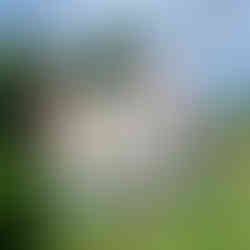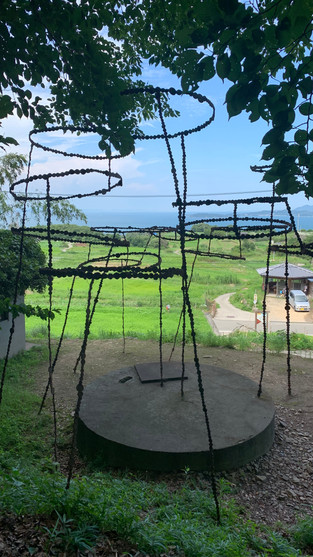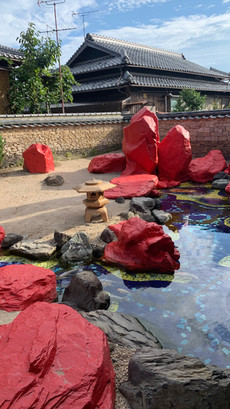Setouchi Triennale Trip: Part 7 - Teshima
- Andrea Antonini

- Apr 26, 2021
- 7 min read
Updated: May 20, 2021
After a couple of hops on the smaller islands of Ogijima and Megijima, I decided to go for something more mainstream and popular and opted for a day on Teshima. The only way to reach this island from Takamatsu is a high-speed boat, which takes only 35 minutes to the port of Ieura. To my disappointment, there were no slower ferries available; I definitely prefer the latter, because they allow you to be on the deck, look at the sea and enjoy the breeze and the views.
Together with Naoshima and Inujima, Teshima forms part of the holy trinity of islands that kickstarted the contemporary art renaissance of the Seto Inland Sea. Some of the installations on Teshima are globally famous, and art lovers from many different parts of the world swarm to the island to visit them. Since it was the peak days of the 2019 Triennale summer edition, the speed boat was well packed with day-trippers from Takamatsu, all ready and eager to fulfil their artsy expectations.

Strangely for an island with such an established international reputation, Teshima is inexplicably devoid of hotels. Accommodation options are limited to a few family-run bed & breakfasts or minshuku, offering very few rooms. They -understandably- tend to fill up very fast during the Setouchi Triennale days. That is probably why the island is mainly visited as a day trip from Takamatsu or from the nearby island of Shodoshima and Naoshima and explains the multitudes of people besieging the morning speed boats.
As soon as I got off at Ieura port, I realised it was paramount to figure out quickly how to get around the island before the hordes of day-trippers would congest every place. The challenges with the infrequent local buses in Shodoshima had left some fresh scars, so I was not keen on repeating the experience on the seemingly more remote Teshima. I had done a bit of research and I knew that nearby the port area there were some bicycle rental outlets. Luckily the sun was shining bright, and I really liked the idea of spending the day pedalling around, with the freedom to do things and visit places exactly how and when I wanted.
I quickly asked some local people at the ferry terminal about the closest options available; then I headed straight for the nearest one. The friendly old man working at the shop probably noticed my far-from-ideal physical shape and recommended hiring an electric bicycle to better tackle the hills and slopes of the island.
Teshima is not flat; there were several moments during the day when I silently thanked the kind man for his wise advice. In all fairness, even with the help of assisted pedaling, some of the roads were not exactly easy! My primary aims for the day were quite clear: book a lunch at the Shima Kitchen art restaurant and visit the Teshima Art Museum.

Shima Kitchen is a restaurant with the concept of bringing people together through food and art. It was created inside a renovated old house complemented by a modern sinuous wooden canopy in stark contrast with the shapes of traditional architecture. They offer seasonal menus based on the local produce and culinary tradition and I was very keen to taste the food and experience the place. Sadly, and to my great disappointment, when I arrived there I found out that the place was already fully booked for the day. The only thing I could do was to mentally picture the appetising menu I saw written on the board.
Fortunately, every cloud has a silver lining! By reaching Shima Kitchen in the hilly area of Karato-Oka, I found out that an installation by one of my favourite visual artists, Pipilotti Rist, was immediately nearby. I soon reached the place, which looked like an old, dilapidated shack; the entrance door was shielded by thick blackout curtains. On a white disc hanging from the ceiling, video projectors were reproduced in loop one of her signature dreamlike fantasies, full of bright colours and soothing sounds.
Back on my two-wheeler, I made my way to the Teshima Art Museum. I knew that it is the hot spot of the island and that most probably I would have to queue for a while before being allowed in. And I was totally right. Luckily, a clever system based on numbered tickets allowed awaiting visitors to move a bit around the nearby area without having to stand in a queue under the scorching sun. I spent my 30/40-minute wait wandering around the complex. From the outside, the low-domed structure looks like an organic element integrated with the surrounding nature; although, at the same time, it gives the impression of an alien object dropped from the unknown.

When I heard my number being called by the bullhorn, I quickly made my way to the ticket office, paid my entrance fee, and started walking down the narrow concrete walkway that winds through the trees. At the entrance, I was asked to remove my shoes, keep quiet all the time, and -sadly- refrain from taking pictures on the inside.
I spent more than an hour in this "art museum that is not an actual art museum". It is more correct to think of the building itself as a work of art, rather than a museum because nothing is exhibited. The softly curving concrete defines a pure white space in the shape of a raindrop. Through the two oval windows, you can see nature outside; from the same windows, the sounds of nature and the wind come in. Small amounts of water emerge from nearly invisible holes and tiny spouts on the floor. The liquid is moved by the wind currents, gathers in reflecting puddles that dot the floor here and there randomly, and then disappears inside the holes again to reappear somewhere else. All elements are connected; everything is cyclical, artificial and yet so natural. I really felt like I was one with the space and the nature around it.
Finally, I came out, and I felt like waking up from a very vivid dream. It soon dawned on me that I had just lived one of the most exceptional and unforgettable experiences of my life. The Teshima Art Museum had no doubt carved a spot among my top ten destinations in Japan.

My appetite was slowly growing, so I decided to pedal downhill (yay!) to the village of Karato to look for something to eat. I found a wonky noodle shop, a fusion between a food-lorry and a shack, run by a smiling young lady and her friendly ginger cat. Since it was summer, my choice fell on cold somen noodles with thinly sliced ginger pork and grated daikon. The cat gave me a look of approval, and when the lady came out with my bowl, he joined me and sat on the floor under my table; he was not begging for food, he came just for the pleasure of company. But -alas- more visits were awaiting and I had to part ways with my ginger friend.
Right in front of the noodle restaurant, one installation caught my attention: a basketball backboard shaped like the perimeter of Teshima and holding multiple loops. It is an invitation to the local people and the visitors to have fun together without any particular rules, or by just making them up. “No One Wins” is the title of this installation by Catalan artists Llobet & Pons.

The next unmissable place on my wishlist was “Les Archives du Coeur” (The Heart Archives), by the French artist Christian Boltanski. The installation is hosted within a small building at the far end of a stunning deserted beach and must be reached by walking on a footpath after the paved road comes to a dead end.

Once in the building, the attendants, dressed in white jackets, show you the way to a completely dark chamber. The only source of light is a bulb hanging from the ceiling to the centre of the room. The bulb goes on and off to a booming sound originating from the far end of the dark place. As my eyes adjusted to the darkness, I realised that the black walls were covered in square mirrors of different sizes. And as I listened more and more to the booming sound, I came to understand that it was an amplified heartbeat. I was totally immersed and surrounded by someone's heartbeat.
The concept behind this installation is very fascinating. The artist has collected thousands of heartbeats from all over the world, and they are played cyclically inside the artwork. In the beginning, the effect is alienating, but the feeling changes entirely once you realise what you are experiencing, and becomes very warm and welcoming. It’s as if the souls of thousands of different people from around the world had congregated in one remote corner of Japan.
Emerging from such a high-impact artwork, I decided it was the right moment to stop on the enchanting beach nearby. I took my t-shirt off and enjoyed the sun and the sea for a while. The beach was really pristine, with spots of wild grass and vegetation, trunks and pieces of wood washed ashore, and very quiet. The sea was crystalline, and I could not resist going in.

After a while in that peaceful corner, I got on my electric bicycle again, making my way back to Ieura. While on the road, my attention was caught by a group of local people gathered in a house made of corrugated iron. It turned out to be a small local festival, where the children had set up an amateur flea market. Watermelons were chilling in the old fountain, fed by a natural spring spouting from the mountainside. Nearby, the “Particles in the Air” sculpture by Noe Aoki, was silently overlooking the scene.
Arriving in the village of Ieura, I caught glimpses of a local community happily revived by the positive influx of the Triennale Art Festival. The roads were teeming with people walking or pedaling around, and I saw a few cute local cafes and restaurants, most of which had a very distinct Showa/retro/hipster vibe. I made a quick detour into the fields nearby to check out the “Needle Factory” installation by Shinro Ohtake. The dilapidated factory, which was due to be dismantled, now hosts the hull of a boat that had been abandoned in a shipyard at Uwajima (Ehime) for more than 30 years. Two forgotten structures now holding each other.

The last stop before heading back to the port was the Yokoo House. In this case, the artist, Tadanori Yokoo, has intervened directly on a traditional house and transformed its architecture by applying non-conventional architectural elements, like the coloured rocks and ponds in the garden, or the transparent glass floor in one of the rooms. The house also contains paintings by the artist and some alien elements such as a narrow vertical tower, the inner walls of which are entirely covered with photographs. It was an impressive artwork to end the day with.
(This article refers to my trip to the Setouchi Triennale in July 2019.)


























Comments